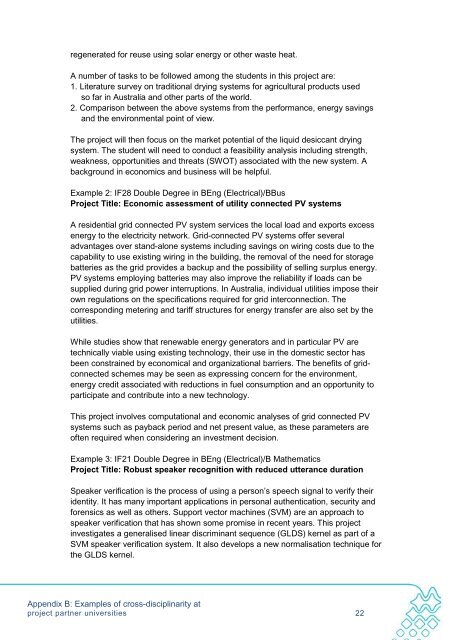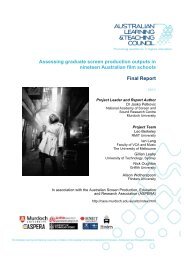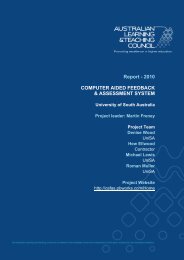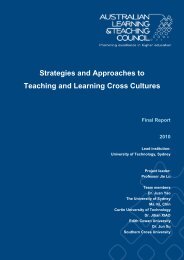Download Document - Office for Learning and Teaching
Download Document - Office for Learning and Teaching
Download Document - Office for Learning and Teaching
You also want an ePaper? Increase the reach of your titles
YUMPU automatically turns print PDFs into web optimized ePapers that Google loves.
egenerated <strong>for</strong> reuse using solar energy or other waste heat.<br />
A number of tasks to be followed among the students in this project are:<br />
1. Literature survey on traditional drying systems <strong>for</strong> agricultural products used<br />
so far in Australia <strong>and</strong> other parts of the world.<br />
2. Comparison between the above systems from the per<strong>for</strong>mance, energy savings<br />
<strong>and</strong> the environmental point of view.<br />
The project will then focus on the market potential of the liquid desiccant drying<br />
system. The student will need to conduct a feasibility analysis including strength,<br />
weakness, opportunities <strong>and</strong> threats (SWOT) associated with the new system. A<br />
background in economics <strong>and</strong> business will be helpful.<br />
Example 2: IF28 Double Degree in BEng (Electrical)/BBus<br />
Project Title: Economic assessment of utility connected PV systems<br />
A residential grid connected PV system services the local load <strong>and</strong> exports excess<br />
energy to the electricity network. Grid-connected PV systems offer several<br />
advantages over st<strong>and</strong>-alone systems including savings on wiring costs due to the<br />
capability to use existing wiring in the building, the removal of the need <strong>for</strong> storage<br />
batteries as the grid provides a backup <strong>and</strong> the possibility of selling surplus energy.<br />
PV systems employing batteries may also improve the reliability if loads can be<br />
supplied during grid power interruptions. In Australia, individual utilities impose their<br />
own regulations on the specifications required <strong>for</strong> grid interconnection. The<br />
corresponding metering <strong>and</strong> tariff structures <strong>for</strong> energy transfer are also set by the<br />
utilities.<br />
While studies show that renewable energy generators <strong>and</strong> in particular PV are<br />
technically viable using existing technology, their use in the domestic sector has<br />
been constrained by economical <strong>and</strong> organizational barriers. The benefits of gridconnected<br />
schemes may be seen as expressing concern <strong>for</strong> the environment,<br />
energy credit associated with reductions in fuel consumption <strong>and</strong> an opportunity to<br />
participate <strong>and</strong> contribute into a new technology.<br />
This project involves computational <strong>and</strong> economic analyses of grid connected PV<br />
systems such as payback period <strong>and</strong> net present value, as these parameters are<br />
often required when considering an investment decision.<br />
Example 3: IF21 Double Degree in BEng (Electrical)/B Mathematics<br />
Project Title: Robust speaker recognition with reduced utterance duration<br />
Speaker verification is the process of using a person’s speech signal to verify their<br />
identity. It has many important applications in personal authentication, security <strong>and</strong><br />
<strong>for</strong>ensics as well as others. Support vector machines (SVM) are an approach to<br />
speaker verification that has shown some promise in recent years. This project<br />
investigates a generalised linear discriminant sequence (GLDS) kernel as part of a<br />
SVM speaker verification system. It also develops a new normalisation technique <strong>for</strong><br />
the GLDS kernel.<br />
Appendix B: Examples of cross-disciplinarity at<br />
project partner universities 22

















